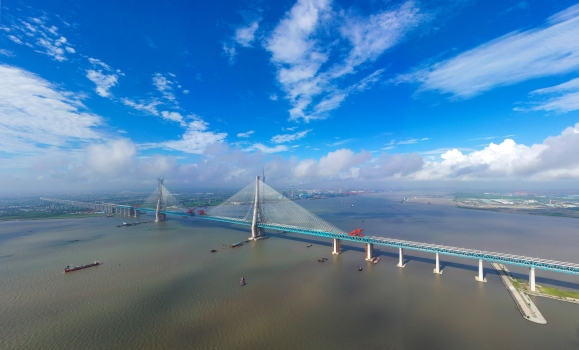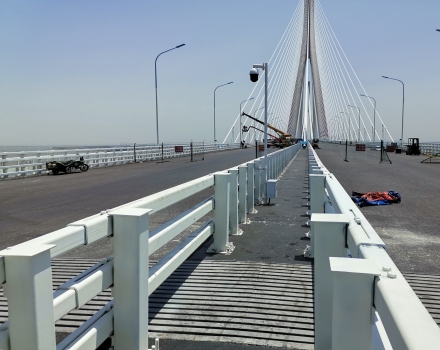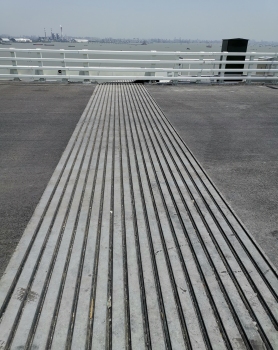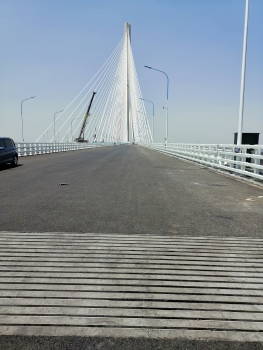Record bridge in Shanghai with expansion joints from Munich
While the Hutong Bridge in China is only the second longest-spanning cable-stayed bridge, and only has the second highest pylons, it is much larger than the firsts, and can therefore be called the world's biggest cable-stayed bridge. The expansion joints needed for such a bridge are no small feat either. They were designed and manufactured in Munich, Germany.
Media
Once again, China has built a record bridge: since July 1, 2020, the Hutong Bridge with a length of 11 km has been connecting Shanghai at the south bank of the Yangtze delta and Nantong at the north bank. For the main bridge featuring a span width of 1,092 m, swivel-joist expansion joints were required that allow for a movement of almost 2 meters in longitudinal direction at both bridge ends. The expansion joints were manufactured at MAURER in Munich.
The “Hutong Yangtze River Bridge” (“Hu” is the abbreviation for Shanghai, “Tong” for Nantong) is a combined railroad/road bridge. The double-decker bridge over the Yangtze delta is 11,076 m in length. The bridge deck consists of a steel framework girder with four embedded rail tracks, two of which are suitable for velocities up to 250 km/h (155 mph). On the upper deck, road traffic is moving on three lanes in each direction.
Two bridge sections characterize the total structure: in the north, a 336-m-long steel arch bridge, in the south, the “largest” cable-stayed bridge worldwide. With a main span width of 1,092 m it is only 12 m shorter than the current record holder, the Russky Bridge (Russia). The two 325-m-high pylons are the second largest bridge piers in the world, surpassed only by the Millau Viaduct (France). Since the road on the Russky Bridge features 4 lanes only, the Hutong Bridge in China has now been declared largest cable-stayed bridge in the world. All of the above-mentioned record bridges – Russky, Millau, and now Hutong – are equipped with expansion joints from MAURER.
Expansion joint with large transverse movements
Expansion joints are installed at the bridge ends to accommodate longitudinal movements of the bridge deck and dynamic structural movements. Long bridges naturally require large expansion joints – the larger the structure, the larger the expansion. In Shanghai, the width required for 6 traffic lanes is an additional challenge. Therefore, the two MAURER Expansion Joints type DS1800 feature 18 profiles and a length of 36.2 m each.
Besides the size of the structure, strong wind and rain loads at the Yangtze delta have to be considered, which is why the expansion joints – besides a transverse movement of ± 50 mm – allow for a longitudinal movement of 1,800 mm.
Since the expansion joints could not be transported at full length, they were manufactured in Munich in two parts each, transported by ship to China in fall 2019 and installed and welded on site.
They were designed as so-called swivel-joist expansion joints. The special feature of such joints is that they are movable in all dimensions: transversely and longitudinally to the direction of traffic as well as vertically. The eponymous parallel swivel joists carry the overhead profiles. They run (except for the edge joists) slightly inclined to the direction of traffic, thus ensuring that the tractive and translatory movements of the bridge are evenly allocated to the joint gaps between the lamellae.
Bridge improves infrastructure
The new Hutong Bridge will considerably change the traffic flows in the regions around Shanghai and Nantong. The nearest road bridges are 40 to 45 km away, the nearest railroad bridge crosses the Yangtze at a distance of 200 km upriver. In this way, some regions could be connected to the railroad network in the first place. Travel time from Nantong to Shanghai is intended to be reduced from two hours to one.
Construction of the bridge started in June 2016. The expansion joints were installed at the end of 2019. The bridge was opened for traffic on July 1, 2020.
References
- About this
data sheet - Product-ID
7679 - Published on:
07/08/2020 - Last updated on:
07/08/2020





 MAURER SE
MAURER SE 
